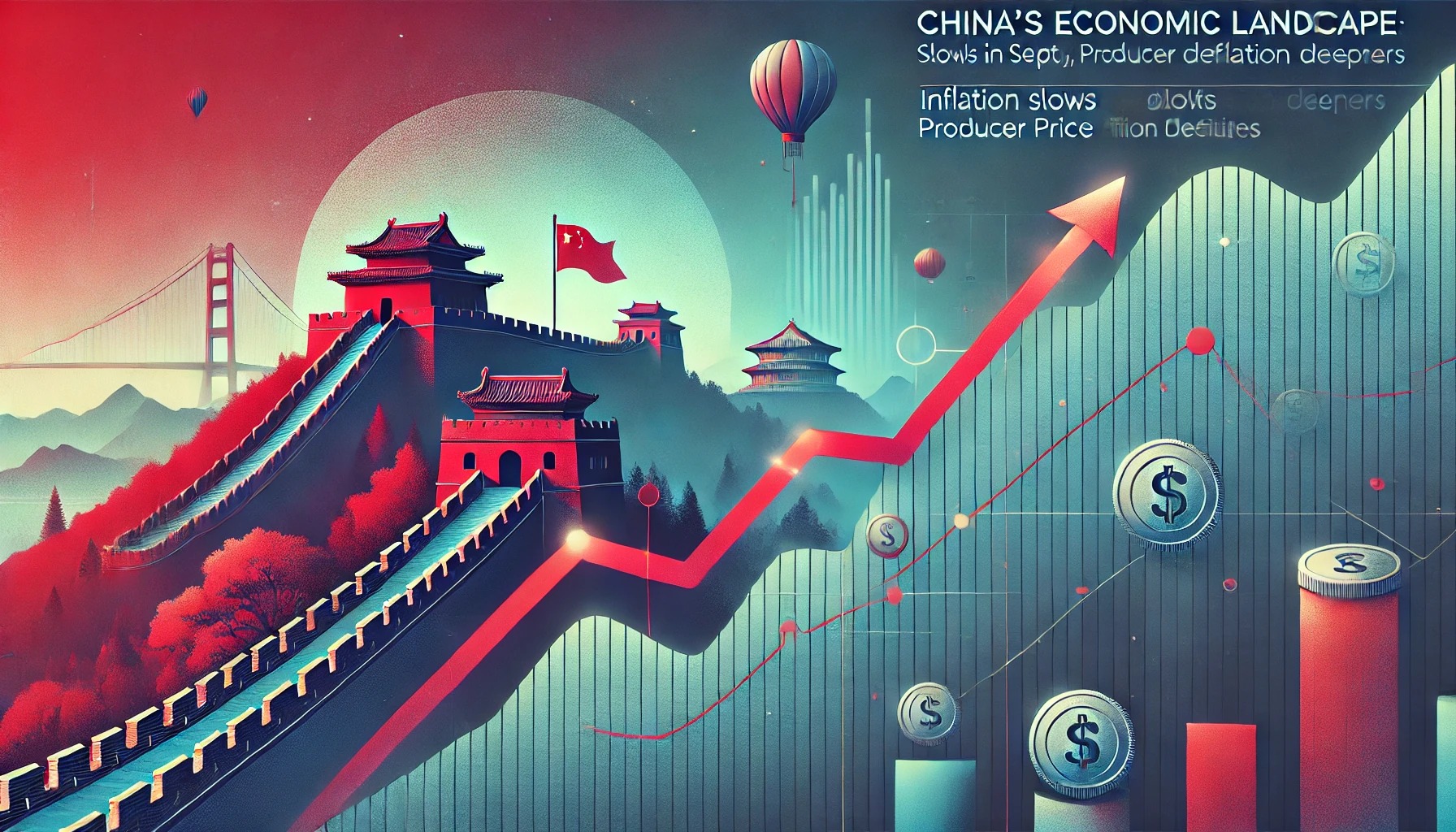China's consumer inflation unexpectedly slowed in September, while producer price deflation worsened, amplifying concerns about the country's economic health and urging the need for additional stimulus measures. The decline in prices has intensified pressure on Beijing to implement quick fiscal and monetary policies to revive sluggish demand and boost economic activity in the world’s second-largest economy.
At a news conference on Saturday, Finance Minister Lan Foan emphasized that the government will introduce more "counter-cyclical measures" this year. However, no specific details on the scale or scope of these stimulus efforts were provided, leaving investors waiting for clarity. Many are hopeful that any forthcoming fiscal measures will help ease the ongoing deflationary pressures.
Key Economic Data Highlights:
- The consumer price index (CPI) increased by 0.4% in September compared to a year ago, down from August's 0.6% rise. This figure fell short of the 0.6% increase forecast by economists in a Reuters poll.
- Meanwhile, the producer price index (PPI) showed a sharper decline, falling by 2.8% year-on-year in September, marking the fastest drop in six months. This decline was steeper than the 1.8% drop recorded in August and also exceeded the anticipated 2.5% decline.
Pressure Mounts for Stronger Economic Stimulus
In response to the worsening economic indicators, Chinese authorities have ramped up stimulus efforts over recent weeks. The country is striving to hit its targeted economic growth of around 5.0% for 2024. Yet, some analysts believe that the current measures may not provide lasting relief, calling for stronger and more aggressive actions from the government.
Late in September, the People's Bank of China announced the most significant monetary support since the COVID-19 pandemic. The central bank's initiatives included mortgage rate cuts and other measures aimed at reviving the struggling property market, which has faced a multi-year downturn.
Looking Ahead: What to Expect from Beijing
Despite these efforts, the Ministry of Finance briefing on Saturday provided little new information, leaving analysts to speculate on what further measures might be introduced. Many are hopeful that an upcoming meeting of China’s parliament will reveal more concrete plans to tackle the economic challenges.
Underlying Economic Challenges
While stimulus measures are urgently needed, several experts argue that China must also address deeper structural issues such as overcapacity and weak domestic consumption. These factors have led to lower prices, forcing businesses to either reduce wages or cut jobs to manage costs.
- Month-on-month, the CPI remained unchanged in September, in contrast to a 0.4% gain in August, and below the expected 0.4% increase.
- Food prices surged by 3.3% year-on-year in September, up from 2.8% in August, but non-food prices fell by 0.2%, reversing the 0.2% increase seen in August.
According to the National Bureau of Statistics (NBS), the drop in energy prices intensified among non-food items, and tourism-related prices, such as airfares and hotel accommodations, saw a notable decline.
Core Inflation and Deflation Risks
Core inflation, which excludes the often-volatile food and fuel prices, also slowed to 0.1% in September, down from 0.3% in August. This further points to rising deflationary pressures, signaling more challenges for the Chinese economy.
As China's outlook remains uncertain, the global market continues to watch closely for Beijing’s next steps in managing its economic recovery.



 Silver Prices Hit Record High as Safe-Haven Demand Surges Amid U.S. Economic Uncertainty
Silver Prices Hit Record High as Safe-Haven Demand Surges Amid U.S. Economic Uncertainty  Austan Goolsbee Signals Potential for More Fed Rate Cuts as Inflation Shows Improvement
Austan Goolsbee Signals Potential for More Fed Rate Cuts as Inflation Shows Improvement  Gold and Silver Surge as Safe Haven Demand Rises on U.S. Economic Uncertainty
Gold and Silver Surge as Safe Haven Demand Rises on U.S. Economic Uncertainty  U.S. Stock Futures Slip After CPI-Fueled Rally as Markets Weigh Economic Uncertainty
U.S. Stock Futures Slip After CPI-Fueled Rally as Markets Weigh Economic Uncertainty  RBA Unlikely to Cut Interest Rates in 2026 as Inflation Pressures Persist, Says Westpac
RBA Unlikely to Cut Interest Rates in 2026 as Inflation Pressures Persist, Says Westpac  Canada Signals Delay in US Tariff Deal as Talks Shift to USMCA Review
Canada Signals Delay in US Tariff Deal as Talks Shift to USMCA Review  Singapore Growth Outlook Brightens for 2025 as Economists Flag AI and Geopolitical Risks
Singapore Growth Outlook Brightens for 2025 as Economists Flag AI and Geopolitical Risks  Japan Exports to U.S. Rebound in November as Tariff Impact Eases, Boosting BOJ Rate Hike Expectations
Japan Exports to U.S. Rebound in November as Tariff Impact Eases, Boosting BOJ Rate Hike Expectations  Asian Stocks Slide as AI Spending Fears and Global Central Bank Decisions Weigh on Markets
Asian Stocks Slide as AI Spending Fears and Global Central Bank Decisions Weigh on Markets  Gold and Silver Prices Dip as Markets Await Key U.S. Economic Data
Gold and Silver Prices Dip as Markets Await Key U.S. Economic Data  Oil Prices Climb on Venezuela Blockade, Russia Sanctions Fears, and Supply Risks
Oil Prices Climb on Venezuela Blockade, Russia Sanctions Fears, and Supply Risks  Oil Prices Steady in Asia but Headed for Weekly Loss on Supply Glut Concerns
Oil Prices Steady in Asia but Headed for Weekly Loss on Supply Glut Concerns  Trump Orders Blockade of Sanctioned Oil Tankers, Raising Venezuela Tensions and Oil Prices
Trump Orders Blockade of Sanctioned Oil Tankers, Raising Venezuela Tensions and Oil Prices  Chinese Robotaxi Stocks Rally as Tesla Boosts Autonomous Driving Optimism
Chinese Robotaxi Stocks Rally as Tesla Boosts Autonomous Driving Optimism  New Zealand Business Confidence Hits 30-Year High as Economic Outlook Improves
New Zealand Business Confidence Hits 30-Year High as Economic Outlook Improves  Asian Currencies Slip as Dollar Strengthens; Indian Rupee Rebounds on Intervention Hopes
Asian Currencies Slip as Dollar Strengthens; Indian Rupee Rebounds on Intervention Hopes  Dollar Holds Firm Ahead of Global Central Bank Decisions as Yen, Sterling and Euro React
Dollar Holds Firm Ahead of Global Central Bank Decisions as Yen, Sterling and Euro React 

























